PRINTAUSTIN 2023
THE CONTEMPORARY PRINT
STEPHANIE ALANIZ
NICCI ARNOLD GREG BAHR CARLOS BARBARENA PATRICK BARBER LINDA BEHAR DOUG BOSLEY DUSTIN BRINKMAN TERESA CASTANEDA
ASHLEY CECIL MARIKA ARELLANO CHRISTOFIDES JUAN CORREA
JULIE COWAN MARGARET CRAIG CELESTE DE LUNA JESUS DE LA ROSA D.A. DIAZ
BETH DORSEY ANITA GIRALDO EMILY GUI JACOB GUTIERREZ JIMMY DEAN HORN, JR. CULLEN HOUSER
MARIA FRATI REINALDO GIL ZAMBRANO MICHELLE MARTIN ANDI NEWBERRY MABLE NI PETER NICKEL PALOMA NÚÑEZ-REGUEIRO
HEATHER RACHELLE PARRISH MIKE PENNEKAMP ANGELA PILGRIM TATIANA POTTS
KENNA BOLES PRIOR PRINCESS RASHID JACKIE RUSHING TALLER SANAAR KRISTIN SARETTE TERRY SCHUPBACH-GORDON
EGOR SHOKOLADOV SARAH SIPLING SHANNA STRAUSS
TYLER THENIKL DELIA TOUCHE & MELIH MERIC MICHAEL WEIGMAN
STEPHANIE WEINER ERIC WILSON
ERIN WOHLETZ
SUMMER ZAH ALEXANDRA ZUCKERMAN
January 23–March 9, 2023
PRINTAUSTIN
PrintAustin Collective is an artist-led nonprofit organization dedicated to promoting the art of printmaking and print collecting. Our mission to the Austin art community and galleries is to share our enthusiasm for printmaking by helping galleries curate, exhibit, and promote works on paper, and to engage a wider audience through in-house artist talks, signings, panels, printmaking demonstrations, and print-focused art happenings during our annual festival held January 15–February 15.
THE CONTEMPORARY PRINT
The Contemporary Print is PrintAustin’s annual juried exhibition and features an independent survey of the traditions and innovations of contemporary printmaking. We are thrilled to partner with Austin Community College for this year’s exhibition and welcome selections by our juror, Rashaun Rucker, an accomplished artist who makes photographs, prints, and drawings and has won more than 40 national and state awards for his work.
Works in The Contemporary Print demonstrate printmaking’s dynamic and fluid nature today, offering distinct styles and techniques that give way to diverse narratives. While some artists find inspiration in their experiences of identity, immigration, and the human condition, others focus on a technical dialogue, drawing from their practice in other mediums as it translates into the printmaking language. While nontraditional or digital output is accepted as a print element, submissions must utilize traditional print media as their primary technique, including lithography, relief, intaglio, silk screen, and monotype.
THE ART GALLERIES AT AUSTIN COMMUNITY COLLEGE, HIGHLAND
The Art Galleries (TAG) at Austin Community College is an academic gallery program located on ACC Highland Campus. TAG is dedicated to the belief that community engagement with the visual arts produces important dialogues, creates new ideas, and gives voice to diverse viewpoints. The Art Galleries comprises three art spaces: Gallery 2000, Gallery 4000, and TAG Art Lab. In each of these areas, they feature works by emerging and established Central Texas artists and ACC faculty, student, and alumni artists. Through their exhibitions and regular programming, they provide educational experiences that cultivate cultural awareness, critical thinking, and artistic expression as a service to ACC and the local community. More information is available at admc.austincc.edu/ tag/ or email them at theartgalleries@austincc.edu.
 Rashaun Rucker
Rashaun Rucker
ABOUT THE JUROR
Rashaun Rucker (b. 1978, Winston-Salem, NC) is a product of North Carolina Central University and Marygrove College. He makes photographs, prints, and drawings and has won more than 40 national and state awards for his work. In 2008 Rucker became the first African American to be named Michigan Press Photographer of the Year. He also won a national Emmy Award in 2008 for documentary photography on the pit bull culture in Detroit. Rucker was a Maynard Fellow at Harvard in 2009 and a Hearst visiting professional in the journalism department at UNC-Chapel Hill in 2013. In 2014 Rucker was awarded an artist residency at the Red Bull House of Art. In 2016 Rucker was honored as a Modern Man by Black Enterprise magazine. In 2017 Rucker created the original artwork for the critically acclaimed Detroit Free Press documentary 12 and Clairmount. His work was recently featured in HBO’s celebrated series Random Acts of Flyness and Native Son. In 2019 Rucker was awarded the Red Bull Arts Detroit microgrant and was named a Kresge Arts Fellow for his drawing practice. In 2020 Rucker was named A Sustainable Arts Foundation Awardee. Rucker was a 2021 resident at the International Studios and Curatorial Program (ISCP) in Brooklyn, New York and is currently a Mellon Resident at the University of Michigan Institute of Humanities. Rucker’s diverse work is represented in numerous public and private collections.
rashaunrucker.com @ruckerarts

5
Taking Up Space: Stephanie, Relief on fabric with applique, 80” x 30”, 2022
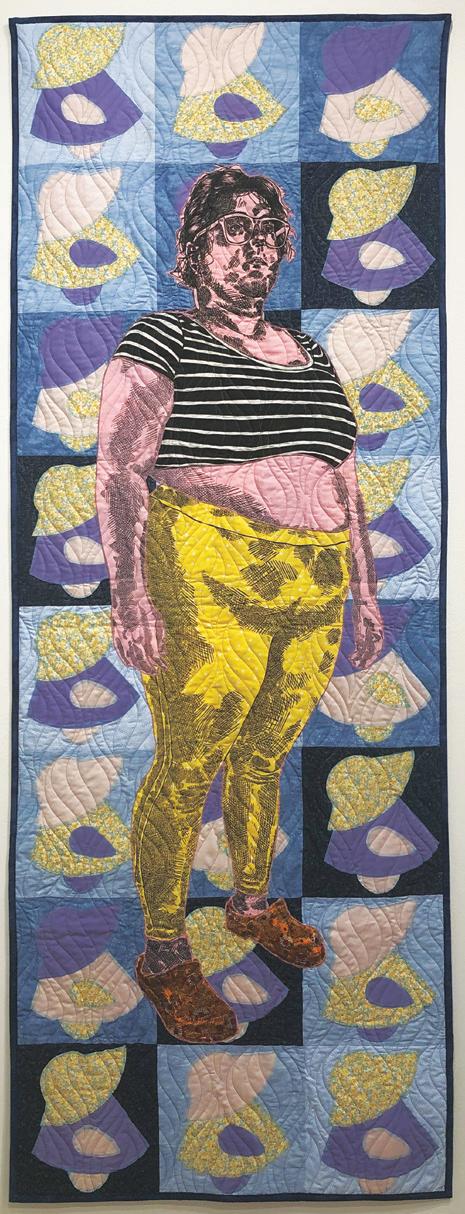
STEPHANIE ALANIZ Emporia, Kansas
My Taking Up Space series is a love letter to my fellow fatties. Existing in a larger body in an anti-fat society is incredibly difficult. People are cruel and hurtful and often treat fat people as if they are the lowest form of life. This work’s intention is to challenge the social norms while deconstructing how we see fat bodies so that we can reconstruct our views through a lens of radical kindness, empathy, and understanding. These large scale quilts feature relief prints on fabric that are then appliquéd to larger quilt tops and assembled quilts. By using the relief process, the action of removing material from the block is meant to reflect the idea that a “good fat person” is one who is actively trying to make their body smaller. However, in the end the block is still a fat person and highlights their fat body.
7
NICCI ARNOLD
Belleville, Illinois
I began documenting scenes of my life in the start of March 2020, just before Covid-19 swept through the world and changed all of our lives. Focusing on spaces I often inhabit and consider my own, I kept a practice of documenting each week with a reference photo I had captured, a scene I felt encapsulated that week, usually featuring objects and spaces. Through this project, I have recorded my own experience as a woman, mother, student, daughter, etc., but additionally the experiences of modern-day society and our collective journey through the past two years.
Encapsulating the approximately twenty-four weeks that our family remained in quarantine, the Quarantine Quilt combines scenes that show the ambivalent nature of parenting and enmeshes them with the monotony of daily life in quarantine. For our blended family, this time was also a rare opportunity to bond and grow stronger relationships. Fashioned after the traditional log cabin style quilts, heirloom fabrics from my mother’s sewing project scraps frame the prints, connecting with a red rectangular center, which traditionally symbolizes the hearth or home.

8
Quarantine Quilt, Woodcuts on Tyvek with heirloom fabrics, 110” x 65”, 2022
GREG BAHR
Fort Worth, Texas
My work explores routine, repetition, color, and pattern. Using images based on daily repetitive movement, I create work that looks at patterns and routine in human behavior such as those that occur in ones’ daily tasks, whether it’s at work, driving, or home. The repetitive and banal nature of most of these tasks allows them to be dismissed in ones’ overall scope of life, yet accounts for a large segment of it. Using repetitive, zen-like processes such as screen printing helps to mimic these tasks while transforming their pathways or images visually.

9
Routescape (Green & Gray), Serigraph on paper, 5” x 11.25”, 2020
CARLOS BARBARENA
Chicago, Illinois
This print was inspired by the experiences of the family members of the 43 education students who disappeared from Ayotzinapa, Mexico. The image captures the mother of one of the disappeared, holding an image of her son in her hand. I aimed to convey both her pain and her determination.
These portraits honor voices that continue to refuse erasure, voices that are overlooked but are never silent. The voices are viewed as coming from the past: already buried, displaced, in diaspora through cycles of oppression and struggle.
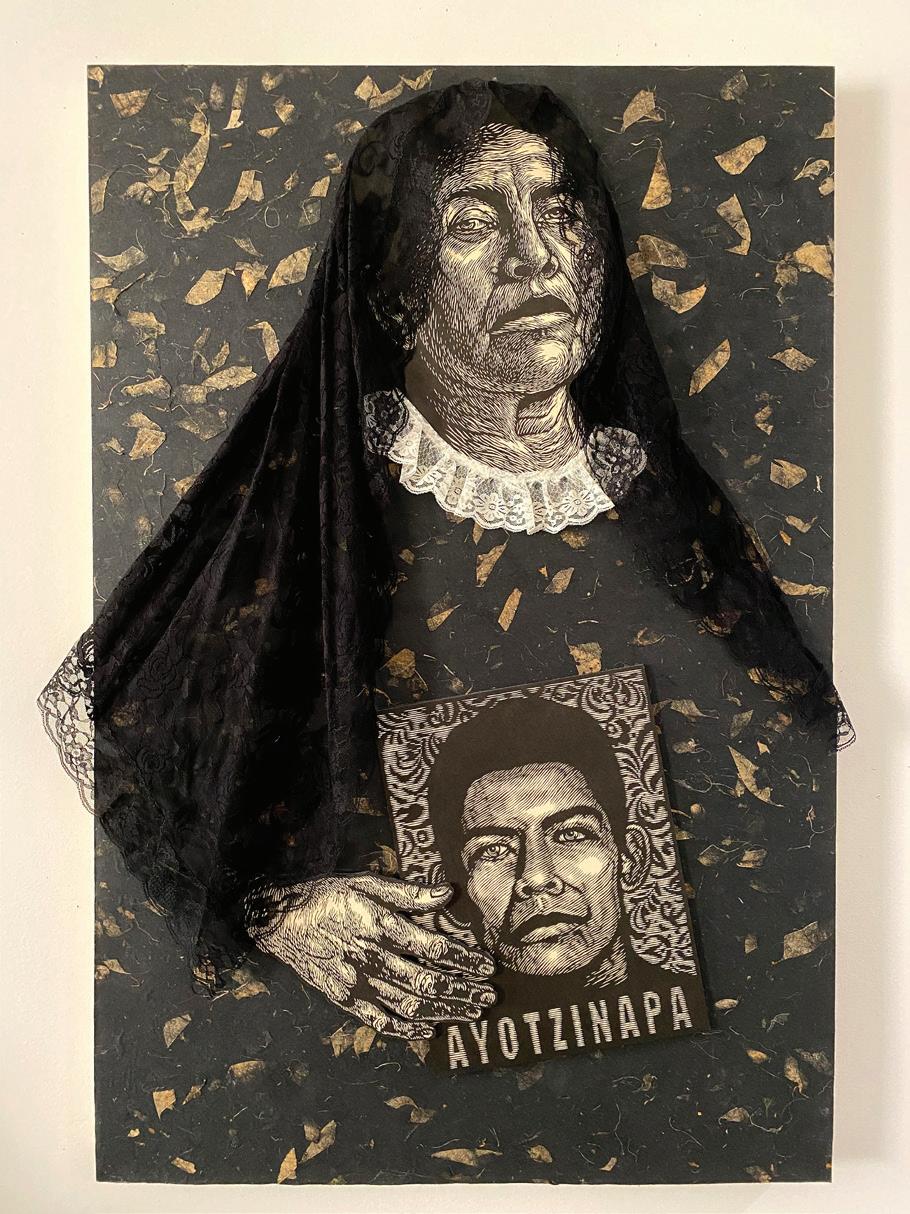
10
Madre de Ayotzinapa, Linocut and mixed media on wood panel, 36” x 24” x 1.75”, 2019
You Have Not Converted A Person Because You Have Silenced Them, Letterpress, 19” x 12.5”, 2021

PATRICK BARBER
Dolores, Colorado
I learned letterpress printing in 2020, after 30 years of working with digital and photo type as a commercial designer. On press, my work is an expressive collision of type, color, and image, borrowing techniques from both my graphic design work and my concurrent practice as an abstract painter. In the work, I seek a balance between intention and receptivity, allowing the invisible moment of impression to introduce unexpected results and combinations.
My work as a printer began under the instruction of Lee Marchalonis, who was at the time the master printer at Signal-Return, the community letterpress studio in Detroit, Michigan. Presently I make work at the Mancos Common Press, which, blessedly, is also a community letterpress studio, in Mancos, Colorado.
I live in Dolores, Colorado, on ancestral tribal lands of the Ute and Navajo people.
11
Amphora, Woodcut print, 30” x 22”, 2022
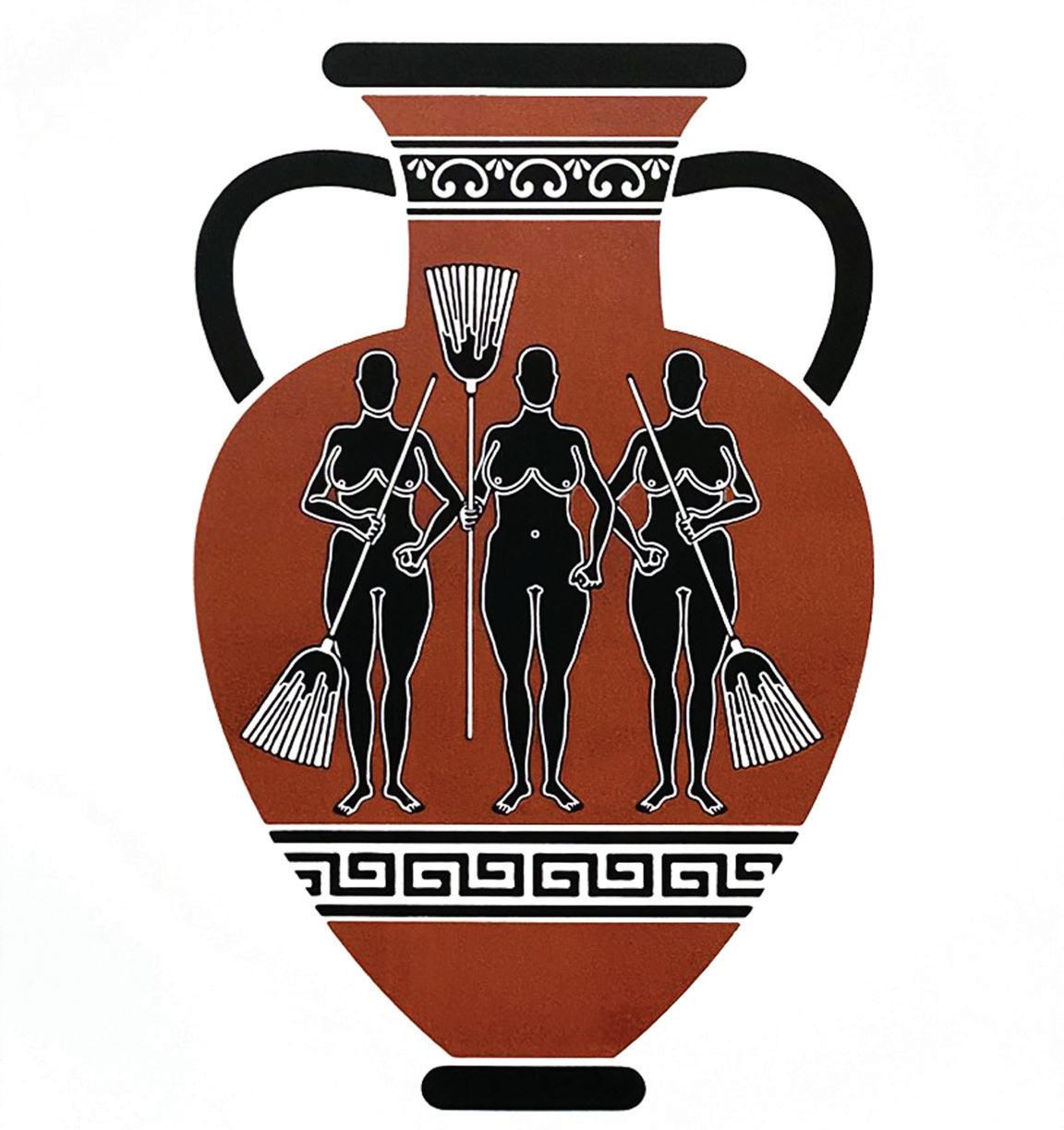
LINDA BEHAR Parkland, Florida
Through my work I explore contradictions, focusing on body language and body shape. Within my research I found a study made by the U.S. government in 1940 which standardized women’s bodies. In it you can clearly see the expectations that society places on women’s appearances which starkly contradict a sense of self.
To understand human behavior is imperative to see it as a whole. In my work, I concentrate on body language and poses as my main theme of consideration. Body language gives a visual form to identity and enhances the visual aesthetics of communication; in other words, when observed, you are what you perform. One of my goals is to create images that echo the past, confront the present and embrace a future. I work in a variety of media.
12
Landfall, Mezzotint, 28” x 12”, 2019
DOUG BOSLEY
Ypsilanti, Michigan
I use detailed imagery and dynamic lighting to lure viewers into a narrative world of my construction. Mezzotint is my primary medium and follows the rich history of printmaking for broadcasting socially relevant content. My work imagines a future version of earth where the familiar environment has been eclipsed by engineered ecosystems and mechanical creations that have run amok.

Central to this fiction are colonies of micro-robots called Auxons. Auxon means ’growth,’ and refers to a specific kind of selfreplicating system of robots that reproduces exponentially until it reaches a critical mass. Once that is achieved, the actions of many individuals working together can perform tasks that previously would have been inconceivable. This suggests great things can happen through cooperation, and that humble actions can aggregate billions of times to have dramatic effects.
I avoid anything too fantastical in my work, focusing instead upon what is physically real and possible. What my work proposes is an alternate history and future timeline with roots in the physical laws and scientific discourse. It suggests that we are agents who can affect real change in the world and must claim responsibility for our actions.
13
DUSTIN BRINKMAN
Columbus,

Ohio
My works exist between departing and arriving, the moments of leaving and returning home. Through a visual vocabulary of Midwest and rural icons, codes, and metaphors, I explore my relationships to the collective spaces of these transient landscapes found on both sides of the front door.
Homes have always appeared to me with scaled stories, the complex multitudes found within or beyond. I am interested in how we create and blur these boundaries of the interior and exterior, the home and house, the body and space. I do not believe these two words are synonymous, but instead act as guides when we reframe and recontextualize the places we recurringly wake up in.
14
Front Porch Shuffle, Relief and silk screen, 20” x 16”, 2022
Memory, Raised graphic monotype, 15” x 11”x 1”, 2022

TERESA CASTANEDA
Denver, Colorado
My printmaking career began in college at age 19 when I took one last class before graduation. Majoring in jewelry and photography, I had my career planned out. It was a printmaking course with E.C. Cunningham that changed my life and career. Material unfamiliarity and his support triggered invention. Within weeks I was selling textural prints, and in months my prints were carried by a publisher, soon I began exhibiting my second technique: 8’x10’ pipe prints. My third invention, “Crinkleism,” earned a National Endowment for the Arts grant allowing me to purchase my own etching press. None of this was the original plan. Continuing to work and exhibit in drawing, painting, photography, sculpture, printmaking, assemblage art, jewelry, and lapidary inspires crossing techniques for inventions. This current process is a combination of jewelry (wax carving and resin), sculpture; death mask commissions, and printmaking. The masks gave me the idea to paint resin into the mold to create a thin sturdy raised graphic plate. Its meaning is simply acknowledging those who made an impression on our lives as well as identifying characteristics. Faces are the first observation that evokes meaning or memory: attraction, beauty, caution, comfort, trust, pain, or love.
15
Healthcare 1, Block printing, acrylic, and wallpaper collage on paper, 16” x 12”, 2022
ASHLEY CECIL Pittsburgh, Pennsylvania
My work is about the parallels between the oppression of women and the domination of nature. Both are religiously sanctioned as property, legislated against, denigrated into submission, their beauty monetized, and their fertility systematically policed. The paintings and mixed-media works are deeply emotional responses to the harm we inflict on nature as well as the tender side of our relationship with it. Their aim is to endear you to the women and wildlife that will determine the future of an entire generation.

16
Petri Dish, Handmade paper and letterpress, 4” x 4” x 4”, 2022

MARIKA ARELLANO CHRISTOFIDES
Stillwater, Oklahoma
My work depicts a feminist bio-scientific imaginary. I draw inspiration from the aesthetics of biological life under a microscope and research non-human organisms like fungi and parasites, using what I learn to invent creatures whose bodies and biological processes I abstract in my work. This imaginary biome allows me to explore ideas of identity, embodiment, and reproductive labor through a feminist lens. The genesis point of my work is a reverence for and desire to elevate mid-century feminine-coded print ephemera: greeting cards, sewing packets, and recipe books which I use to create digital collages. These materials are reminiscent of the domestic spaces to which they belong and often carry an aura of use in the form of handwritten notes or dog-eared pages. Through a process of repetitive mirroring, images of objects like flowers and aprons acquire an otherworldly quality and transcend their original context. By situating my works within installation environments, I extend the act of collage to the gallery wall. In this way, I emphasize the materiality of the prints, referencing the body and building a world around them that suggests ideas of parasitism, symbiosis, and mutation.
17
JUAN CORREA
Iowa City, Iowa
My work visually alters and reinterprets traditions, experiences, and symbols of my childhood: referencing memory, mortality, and identity through highly rendered and detailed drawings and prints. I attempt to give viewers a snapshot of an interiority constantly striving to find equilibrium. I create windows to vulnerable headspaces focusing on coping mechanisms, anxieties over unknowns, and harkening on decisions made. Intimate scenes highlight an uncomfortable but relatable tension. I use this discomfort to share narratives that attempt to reconcile opposing views and ideas of self-perception examined through a bifocal lens of my formative American and Latinx values.
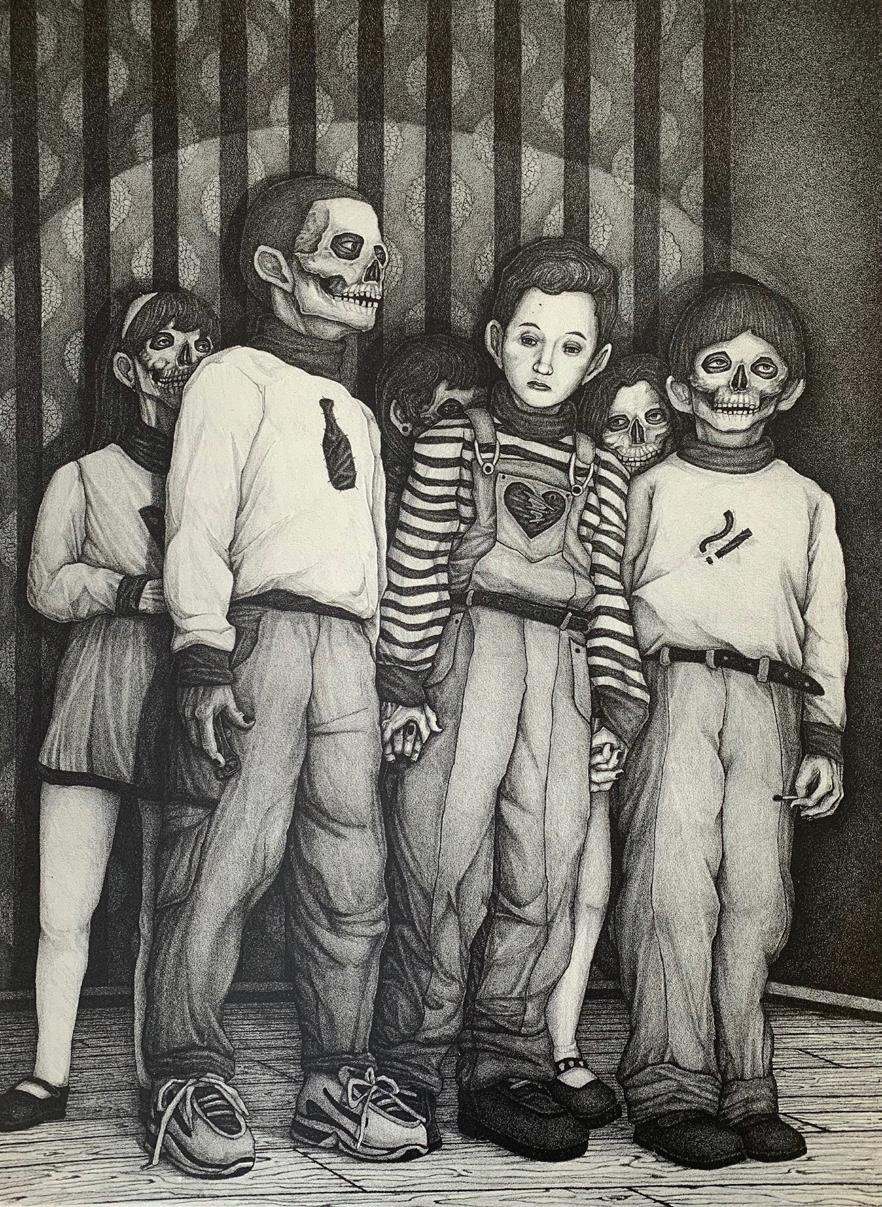
18
Los Cariñositos, Stone lithograph, 22” x 16”, 2021
JULIE COWAN
Evanston, Illinois
This work transforms photographs of text from the redacted version of the search warrant affidavit at Mar-A-Lago in 2022, into a lithographic image, created to construct new meanings and ideas in the viewer. The matrix is a digital image which I manipulated and tiled so that the print is built of discernable separate parts and are then assembled as a whole. Ambiguity is created by the texture and disturbances in the printing outcome as well as the abstraction of the graphical image. What was a federal government document becomes radically different in composition, in visual display, and in meaning.
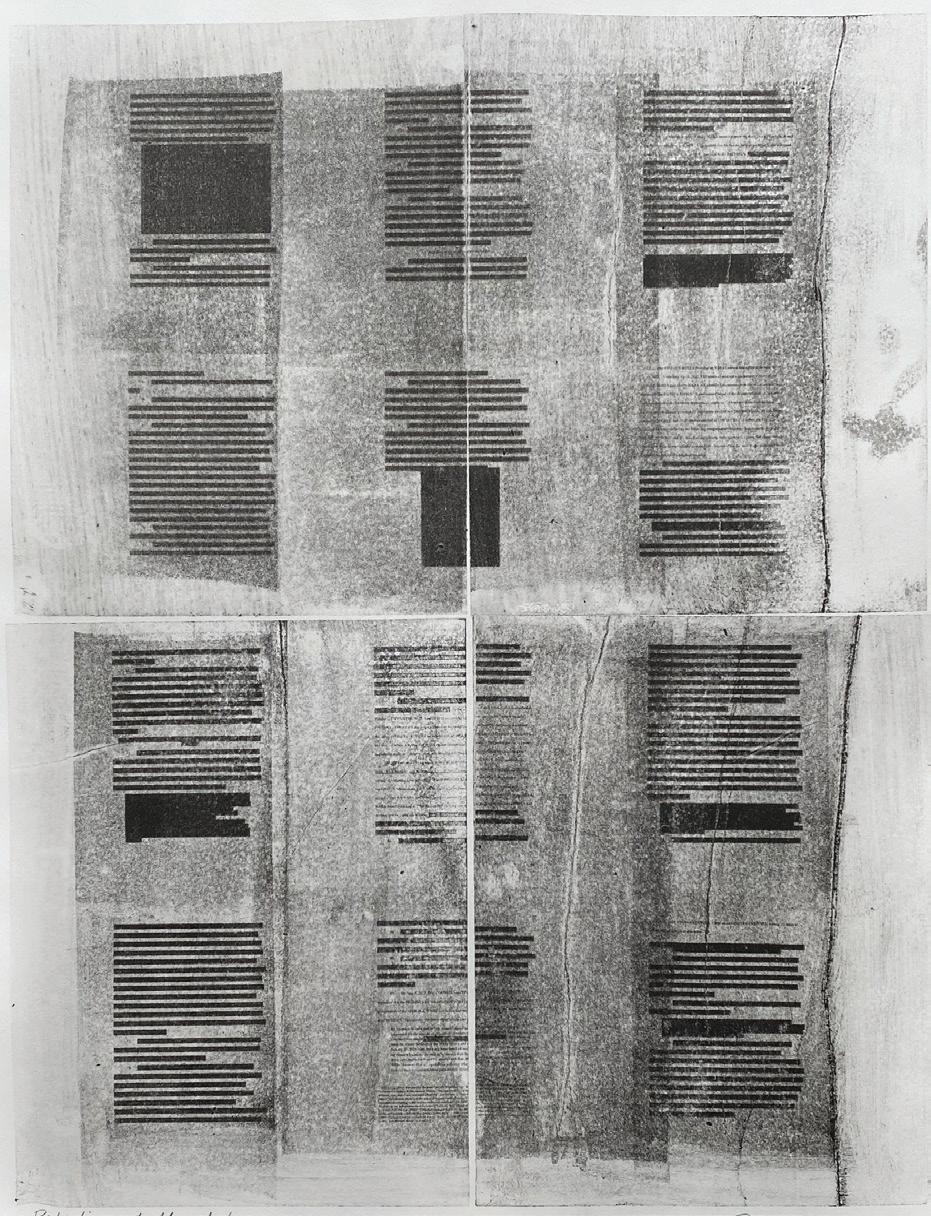
19
Redactions at Mar-a-Lago, Lithography, 30” x 22”, 2022
Bleached Reef Creature (Sculpture), Tar gel etching plus repurposed plastic, mixed media, and light, 15” x 15” x 20”, 2021

MARGARET CRAIG
San Antonio, Texas
My original college degree in biology has been a major influence in both the visual and ecological context of my work as a printmaker. My work is rooted in the symbiotic ecostructure we all precariously live in, and involves an elaborate, possibly excessive, process that (re)cycles the original post-consumer paper and plastic through several art forms and media, including acrylic, watercolor, printmaking, papermaking, and sculpture.
I have been working on an ongoing print installation sculpture and performance series titled The Great Trash Reef since 2015. Its latest incarnation is the Creature from the Bleached Lagoon which references Japanese Kaiju movies and B movie monster flicks. Constructed from my own recyclables, plus debris I’ve collected from the streets and beaches (preventing it from ending up in an ocean or landfill), The Great Trash Reef takes recognizable material and transforms it into something incongruously beautiful. This personalization of waste allows viewers to more directly engage with our ecological issues, especially the pollution of our oceans and waterways. My imagery is derived from nature, mimicking and abstracting the patterns nature creates.
20
37”, 2020
CELESTE DE LUNA
San Antonio, Texas
The Texas landscape, with its history of colonization, revolution, land disputes, and border walls are of interest to me because of how it impacts how people, animals, and nature move and change by this built environment. My narratives are personal, feminist, fantastical, and perhaps not so fantastical at times. These narratives allow me to traverse time and space.
My work documents individual and collective experiences in my physical/spiritual/psychic environment. It’s a way of connecting and understanding the world. I explore the complexity of relationships of peoples and their landscape. Understanding native liminal space means understanding the contradictory and complex negotiations that shape public and intimate lives. My vision is continuously expanding of the Texas landscape and the Southwest, the frontera, and people. At the heart of my work is being deeply rooted to place, keeping time, telling/remembering visions, stories, and people.

21
Paranoia Quilt, Mixed media printmaking, 64” x
JESUS DE LA ROSA
Kingsville, Texas
Sometimes, a river or a mountain range will determine the boundary between people. Every so often, this borderline is only the ink of a line drawn by man. Through my artwork, I document and react to the ever-changing landscape of the borderland. Cultures, languages, and identities constantly conflict and bind in this space. I work with layers and images in a variety of media. I see these layers and images as metaphors for the phenomena of cultural appropriation, the crossing of cultural, economic, social, internal, and historical borders, or disclosure of the human condition. I make work that coerces these layers to interrelate, coexist, and come into synthesis. Understanding these languages through my work allows me to merge differences and similarities and make sense of my place within this framework.

22
Ancestors, Graphite and Screen print, 22” x 30”, 2022
D.A. DIAZ Eagle Pass, Texas
Nahuatl Graffiti is part of my series documenting immigrant stories here on the border. It’s a mixed bag of fun-looking calacas on adventures and a more serious side of images depicting hardships immigrants go through as they attempt to cross the border. All images originate from stories that have happened in or around my hometown of Eagle Pass, TX. As someone who has family who have immigrated, and family and friends who work in law enforcement both on a federal and state level who are currently dealing with the issue, these stories hit close to home on different levels.

23
Nahuatl Graffiti, Linocut, 9” x 12”, 2022
Undulations1, Polymer photogravure, 21” x 42”, 2021

BETH DORSEY
Minneapolis, Minnesota
The work explores the tension between structure/intentionality and randomness/spontaneity. I am attracted to everyday objects with repeatable elements/patterns such as Venetian blinds, grates, building facades, windows, and corrugated material. These repurposed objects and patterns form the foundation of the images. Layers are added which obscure and enhance the structure.
24
ANITA GIRALDO
New York, New York
I am a New York-based artist and designer. My latest work is Democracy Spoken Here , a series of limited-edition prints using a variety of print methods: letterpress, silkscreen, RISO, offset, and more. This series uses minimalist line drawings, the typeface Clarendon, and only two colors: red and black. Digital pre-production practices are combined with analog execution on fine art papers to realize the printed image.
Democracy Spoken Here is a response to a period of an America particularly high in political turbulence; in actuality, the United States has rarely been easy-going in its political heritage. What makes this period particularly unsettling is the immediate heightened reaction to current events.
Democracy Spoken Here aims to address these reactions by asking the viewer to reflect on their thoughts and emotions through graphic representations of them.
25
God Loves Guns, Letterpress, 22” x 15”, 2020
Chairs, Screen print, 60” x 192” (height variable), 2019

EMILY GUI Crockett, California
My work examines the depth of human experience in the built world, in particular, functional objects that are easy to ignore through daily use. My prints use flatness and facsimile as tools to explore dysfunction. Exerting a kind of effort in order to hang with “natural” perspective, they reach all the way to the ceiling, to reach all the way to the floor. By re-rendering the invisible, I’m interested in highlighting the mundane, forgotten, and unused to invite the viewer to look closer. At the brink of familiarity, the work challenges habits of devouring images and objects while encouraging slow-looking.
26
JACOB GUTIERREZ
Albuquerque, New Mexico
Growing up and experiencing life can be difficult in many ways, but I knew that a trip to Grandma’s house could fix anything I was going through. I never felt more at home than when I was sitting in my grandma’s kitchen while she made tortillas and beans. I felt safe and protected when I would stare up at the walls seeing all my family members honored with their own special place on the wall. I like to think that my grandma hung up pictures of family members and saints right next to each other because she knew every family member was just as sacred as the saints and they all held a special place in all of our hearts.
I love printmaking and making art, but more importantly, I love my family. I believe there is nothing more sacred than family. I used to pray in church and ask God to protect me, but now I turn to my family for protection. In my work I utilize religious iconography for various reasons. It gives me an opportunity to explore different perspectives and challenge the ones we’ve always known. It also allows me to portray my favorite subject matter, my family, in the light they deserve to be seen in. I want to continue to push the boundary of how we view divinity and sacredness by using our own personal experiences.

27
Sacred Mother, 7 Layer woodcut and 1 layer lithograph, 34” x 27”, 2021
The One That Sits Above, Intaglio and block print, 27” x 50”, 2022
JIMMY DEAN HORN, JR. Los Angeles, California
I am Jimmy Dean Horn, Jr, a Chickasaw artist. I draw, paint, print, and create in any way I can. My recent printmaking series The One That Sits Above explores what it means to be a white passing as Native American in a society built on entitlement, bent on destroying itself, and consuming everything with it. I grew up in a military family and a child of divorce, detached from the Chickasaw culture. In the past decade, I have been learning and unlearning as I explore a culture I was denied. Each of the pieces within this series (20 in total: 10 full-size 27”x 50”, 10 portrait 18”x 24”) touches on a different aspect of connecting with Native American culture and how it relates to modern living. These pieces use a nontraditional intaglio process, block prints, and at times hand-drawn embellishments. I created these pieces without using a press, and try to work with recycled or eco-friendly materials and processes when possible.

28
CULLEN HOUSER Madison, Wisconsin
Fine tuning the amalgamation of art with technology and dissolving the distinction between the digital and analog has been a primary focus of my research and art practice. Within my process of building environments reminiscent of the early internet era, I explore the layering of printmaking, materiality, and the flux they have in the final product. Pulling from a lexicon of digital imagery, often clashing or overlaid to create chaotic landscapes, fosters a love/hate relationship with technology. Through the lens of dystopia, patterns and various mark-making methods start to decay, revealing a dilapidated digital world yet to be excavated. My work functions as a means of reflection and regurgitation of the everyday internet experience, creating simulacrums of distorted online spaces that exist on the borders of abstraction and tangibility.
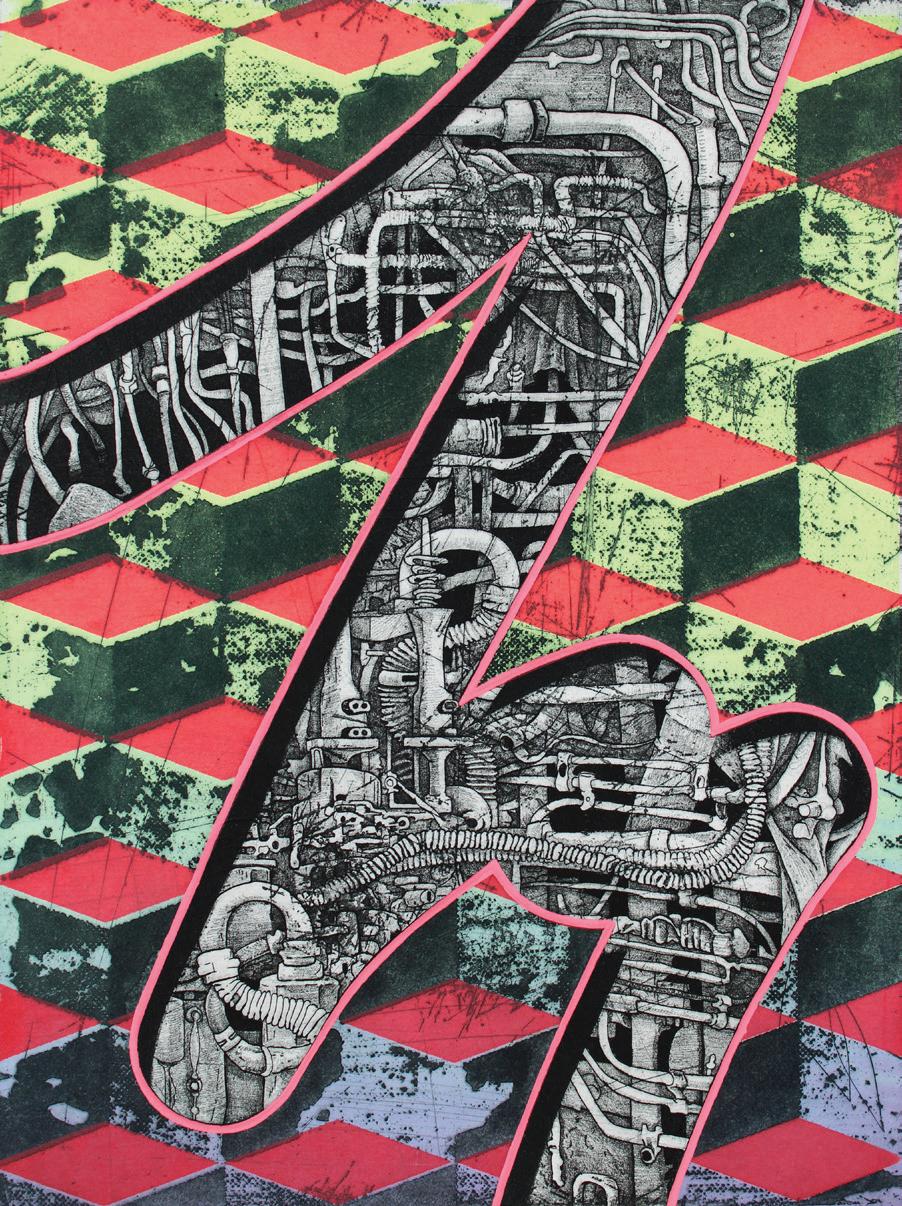
29
Erasure, Etching, Screen print, and gel pen, 12” x 9”, 2021
The Start, Linoleum reduction print, 30” x 22”, 2022
MARIA FRATI
Raleigh, North Carolina
My work is inspired by my deep connection with the natural world: be that through lived experience, memory, and personal mythology. My printmaking process is time-intensive, experimental, and intuitive. Each print uses the layering of multiple smaller plates to make the whole. I generally work intuitively in series to explore a specific shape language. Each series will have common elements but each print is unique like a monotype.
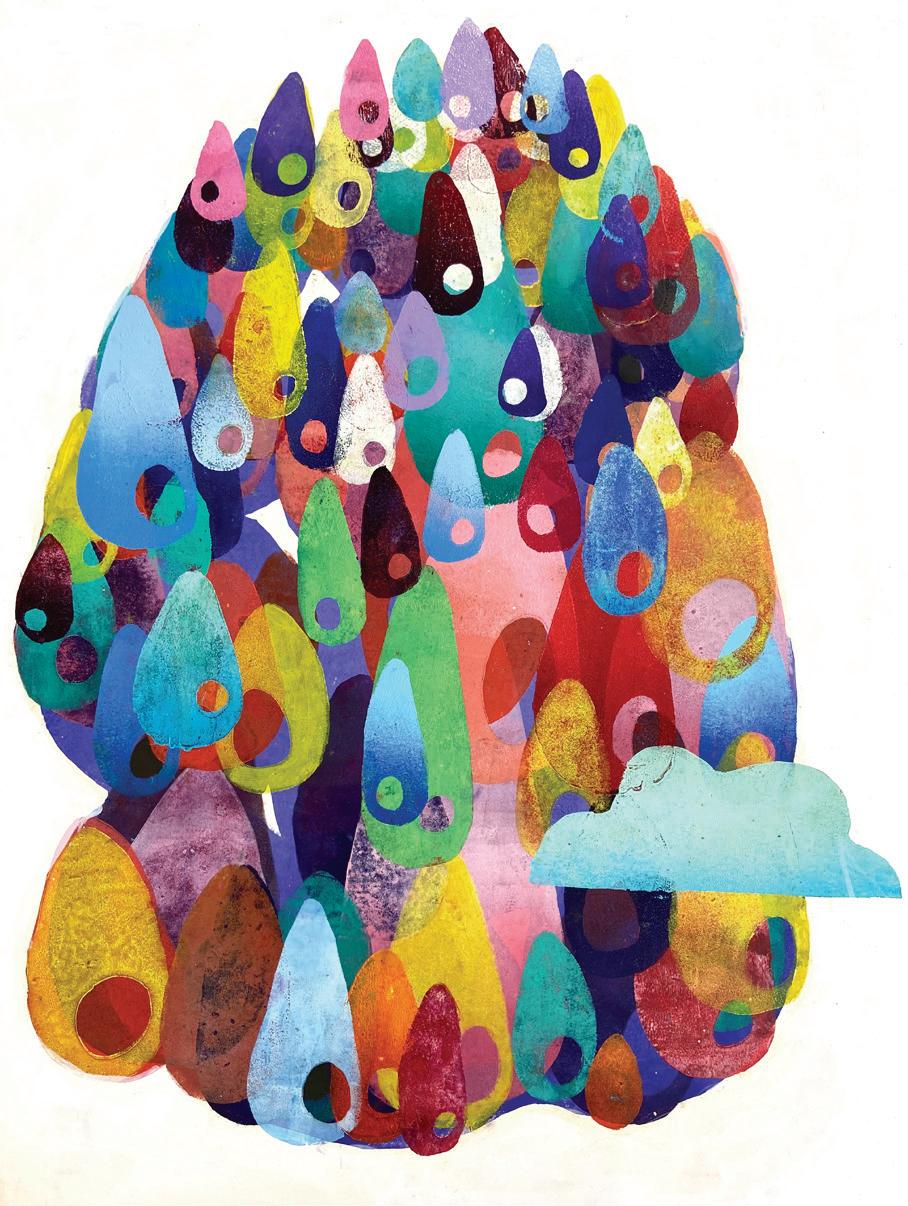
30
La Sopa: Como decía mamá, Xylography, 40” x 25”, 2019-2020
REINALDO GIL ZAMBRANO
Spokane, Washington
My narrative raises questions of daily issues equally experienced by people across cultures and borders using relief printing as a storytelling tool to illustrate and reflect. I study the universal idea of home and how it affects individual personalities by exploring iconography derived from the Majority World and fascinating storytelling inspired by Hispanic literature’s magical realism, food and children’s books from the Venezuelan Rosana Farias. My wordless visual narratives challenge the limitations of the written language and bring people together to celebrate the commonality of our collective experiences.

31
The Leap (II), Photopolymer etching with Chine-colle, 21” x 15”, 2019
MICHELLE MARTIN
Owasso, Oklahoma
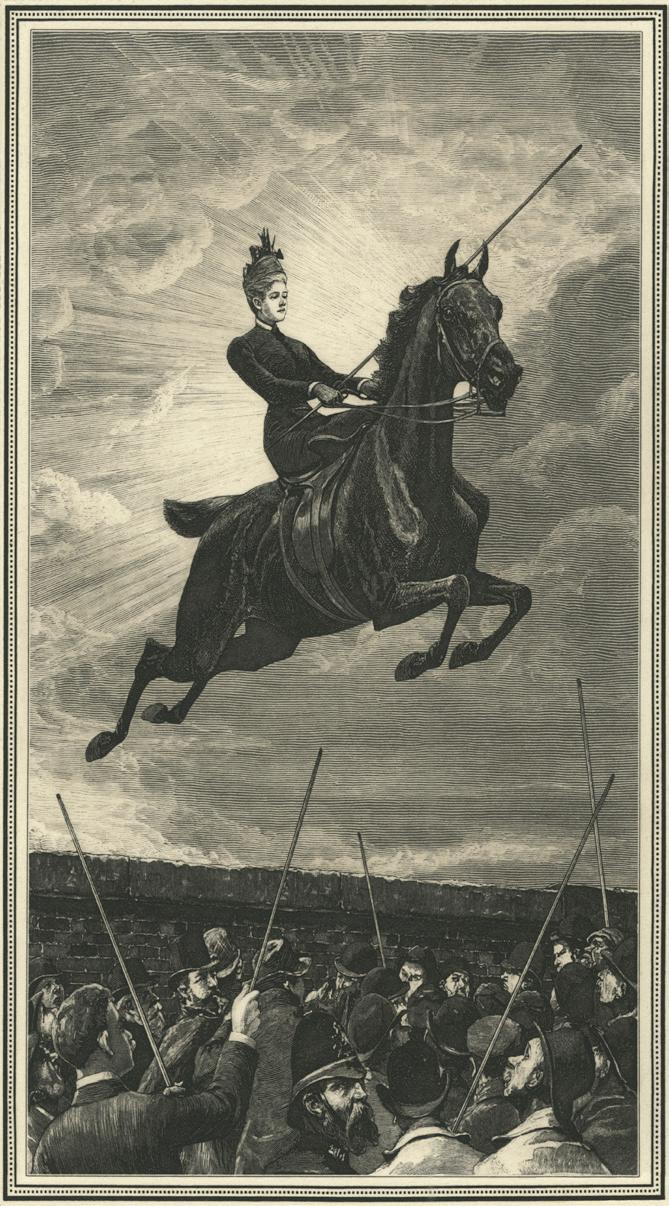
I am interested in the depiction of social interactions and societal commentary through experimental, nonlinear narratives created by using preexisting source imagery in a collage/drawing/printmaking–hybrid process. My work focuses on pushing the traditional boundaries of collage, combining it with digital drawing and hand-printing techniques in such a way as to create images that appear to be “unbroken,” with no obvious delineations that point to the disparate sources of the original images. I draw from sources as varied as the Old Masters and Victorian-era popular imagery to create seamless prints that belie their heterogeneous origins. The resulting prints have prompted viewers to wonder not just how they were made, but when—are they historical artifacts or contemporary fictions?
Both monumental and intimate in scale, the historic images I repurpose are seductive. They encourage in viewers a nostalgia for fairy tales and whimsical stories, and yet they also generate disquieting and open-ended narratives that serve as a form of stealth political and social commentary. Exploring themes of monstrosity and hybridity both in concept and execution, my work investigates the modern experiences of identity, fear, and desire filtered through a historical lens.
32
Going Nowhere Fast, Silkscreen and cyanotype with various fabrics, 19” x 14.5”, 2022
ANDI NEWBERRY
Longmont, Colorado
Memories are catalysts for storytelling; they continuously fluctuate, evade being pinned down, and they contribute to the sum of our sense of self. Different memories synthesize in my pieces, causing partial, fragmented narratives to emerge. These spliced narratives result in compositions populated by symbols ranging from generally recognizable to intimate, creating a balancing act between vulnerability and concealment to the viewer. I’m also driven to explore physical record keeping in my work, such as note-taking and photographing, as somewhat futile attempts to preserve memory and mark existence.
With my textiles, various hand-printed fabric pieces with screenprint, intaglio, or cyanotype present opportunities for choice and structure, but also for spontaneity and experimentation when it comes to sewing them together. Collage and mixed media techniques influence this work, as well as the idea that textiles inherently contain layers of embedded memory in their material. Whether on paper or fabric, my art is a carrier of my beliefs, my love, and my desire for something greater and definitive in an unstable world. Just as giving a verbal recollection of an experience results in a slightly different version of that memory, my art delivers a version of the sum of my experiences.

33
送面, Monoprint, 28.5” x 22”, 2022
MABLE NI Spartanburg, South Carolina
My recent series of monoprints deals with when my parents had a Chinese take-out restaurant. The majority of my childhood was spent there doing homework, helping out, and making up random games to play in the small lobby. This monoprint, 送面, plays with the Chinese restaurant aesthetic and the iconic Americanized noodles that are served in every take-out Chinese restaurant. In several ways, those noodles, along with the other Americanized dishes represent Asian Americans as they give and take from their living spaces and their cultural background.

34
Free Fall, Stone lithography, 48” x 36” x 1”, 2020
PETER NICKEL
Austin, Texas
In my recent images, I seek to depict situations presenting contrasting contexts in order to present to the viewer conflicting ideas simultaneously. Some of the dualities I wish to explore are the contrast between power and innocence, assertive and aggressive natures, and the results of unintended consequences.

35
PALOMA NÚÑEZ-REGUEIRO
Ann Arbor, Michigan
Staying put for too long is part of a series of portraits called Allegiance. In this linoleum print portrait, I push the boundaries of my printmaking practice by exploring the lights and darks of portraiture, the gesture of the cuts, and space between them that give place to a wide array of gray tones.
To me the act of carving linoleum is equal to bringing light to the darkness of the plate. It is a once in a lifetime opportunity because once I cut too much, there’s no way to go back. The same happens in life. We need to closely observe our reactions and our decisions in order to take the opportunity to make things right, because that specific opportunity may only come once. By making the right decisions we will be able to raise each other into better places, socially, politically, and economically. The beauty of the person depicted in the print and the use of the relief printmaking technique creates a connection with the viewer. It is my wish that through this connection we become aware of who we are, and of the power we have in us to make things right for everybody.

36
Staying Put For Too Long, Linoleum print, 24” x 18”, 2022
Other Eye II (Bottomlands/Parkway), Polymer photogravure and Chine-collé, 27” x 20”, 2022
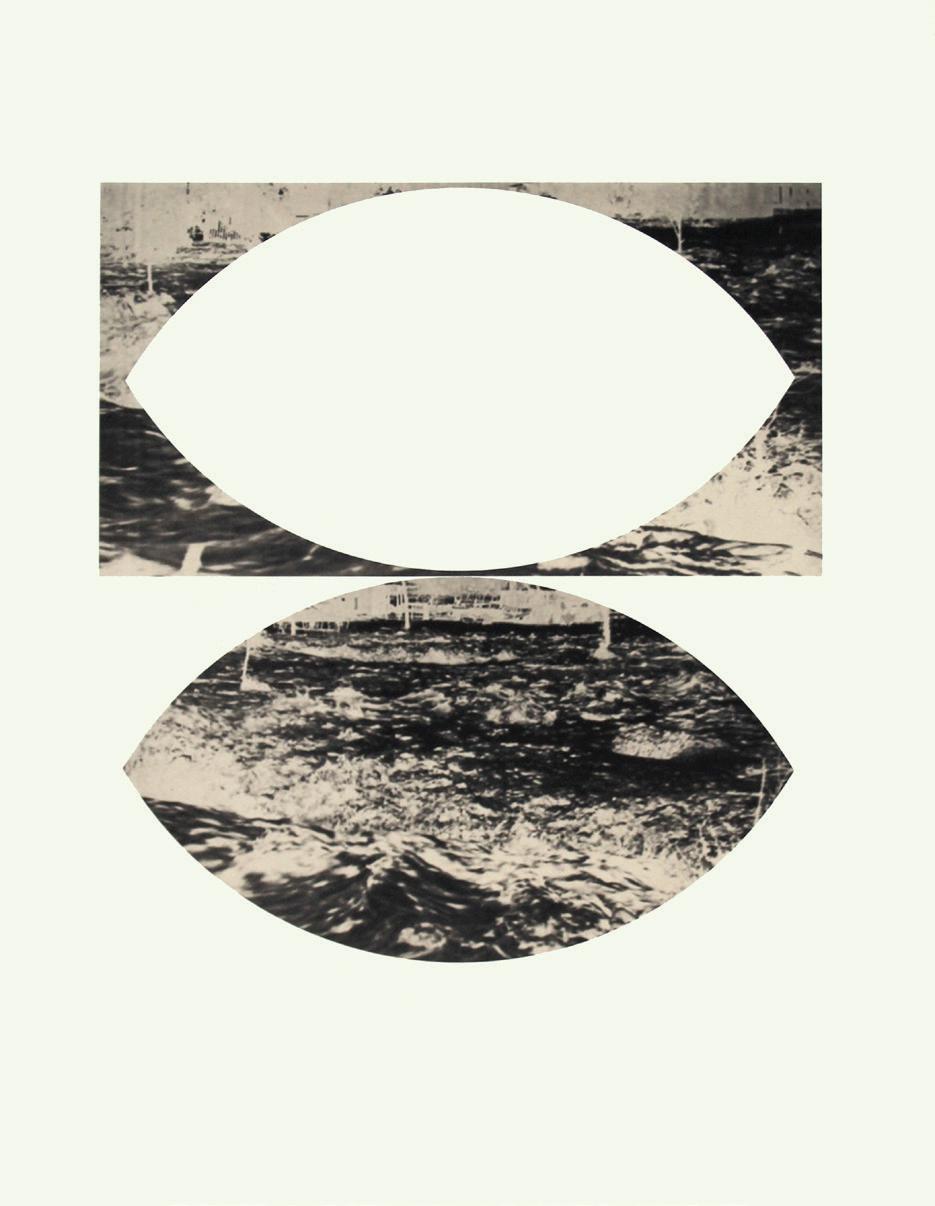
HEATHER RACHELLE PARRISH
Iowa City, Iowa
My artistic inquiry employs printmaking, experimental photography, collage, and installation to unsettle simple binaries and consider complex embodiments of boundaries. Rather than firm and fixed, I explore the fluid potential of boundaries as porous sites of exchange. Born in Austin, Texas, I spent formative years of my childhood in Southeast Asia. This experience underlies a heightened sensitivity to negotiations of belonging, identity, and connection to land.
Other Eye II (Bottomlands/Parkways) is part of a bigger project, Seeing Out the Other Eye: A View Through Waller Creek . This cretaceous limestone waterway is remembered (sometimes forgotten) as a dividing border line that runs through the heart of Austin. Bearing the name of Austin’s first city planner, this flash flood prone waterway is inscribed with legacies of racialized division and displacement. As an Austin native with family traces to the city’s founding, I hold a sense of responsibility to explore these harmful legacies, with the hope that critically excavating the past and present may serve to reinscribe a more life-affirming, equitable future.
37
MIKE PENNEKAMP
Chicago, Illinois
Continuously fueled by a DIY punk ethos, my work is influenced by conspiracy and revisionist narratives in a post-truth American landscape. Referencing imagery and themes spanning from Art Historical canons to the the pages of alt-comics, genre films, and album covers, I combine and blur the line between high and low art while connecting dots and drawing correlations between events of the past and the present while celebrating the craftsmanship and traditions of printmaking. Or maybe that’s just what I want you to think.
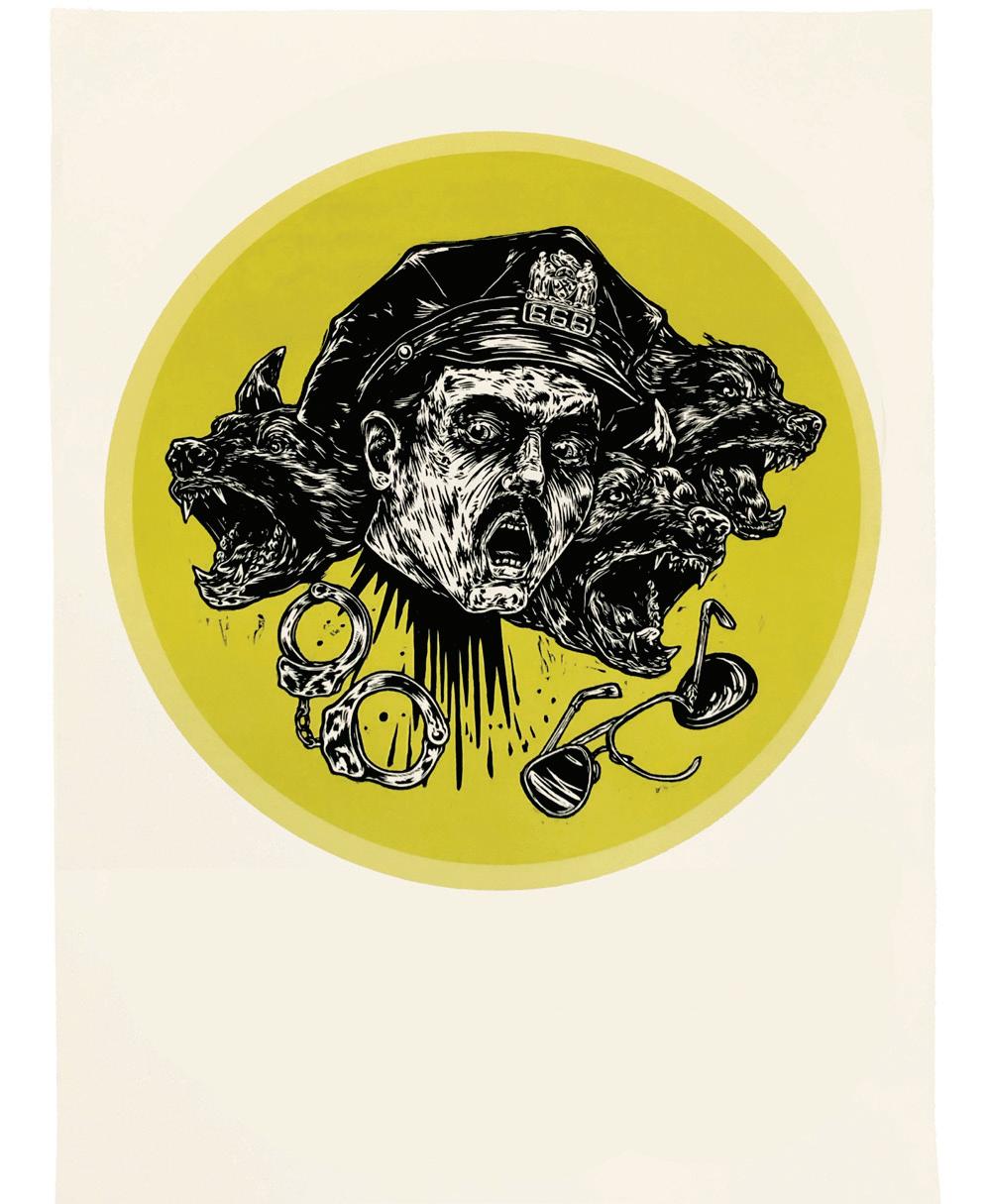
38
Gorgoneion (After Caravaggio and Pettibon), Woodcut, Screen print, 18” x 24”, 2020
Fertile, Screen print and mixed media on paper, 22” X 30”, 2022
ANGELA PILGRIM
Newark, New Jersey
My work explores the Black female gaze through figurative imagery of the body. Utilizing portraiture, printmaking, pattern making, and mixed media, I investigate themes of beauty, spirituality, and reflection. By creating visual stories that invoke critical thinking processes regarding interiority, my work aims to reverse and rebuild how Black women see themselves, both within their communities and in to a much larger world-view.

39
Meeting Place, Screen, relief and intaglio, book, 5” x 4” x 8”, 2022
TATIANA POTTS
Oakridge, Tennessee
My work transforms images, artist books, and paper installations into a new world. These pieces are composite memories that reflect my experiences and perspectives living, traveling, and studying in Europe and the United States. The imagery is created with various printmaking processes.

Being a person from a country that no longer exists, I find myself cobbling an identity from my adopted country, the United States, and my country of origin, Slovakia (as well as all the places I have lived in between). World building is important because as a nonnative speaker, I am often put in the role of “other”. My works allow me to travel to a place where I am not an “other.” I belong. I like the viewer to have a more intimate experience, so that they feel like a part of my world too. I create small sculptural books to encourage a connection between the work and the viewer, as they are easier to interact with.
I combine the constantly changing nature of culture, language, physical geography, and architecture to make my own fluid and responsive language.
40
Evidence, Photogravure, 5.5” x 7.5”, 2014

KENNA BOLES PRIOR Cedar Hill, Texas
My creativity has made me a survivor of life. Or maybe the abuses of childhood forced a creativity in order to survive. The conflict of beauty and reality exist together. It has been my journey sorting through the details trying to make sense of it and finally releasing it through my art: a mirror of my history, my conflicts.
I draw inspiration from objects—aged, broken, and abandoned—for either the beauty itself or in the stories that lie within them. Finding these items, like finding beautiful memories, may not be mine, but are proof of possibilities, leaving me to continuously experiment and explore interactions between them, and how they may mirror life or my interpretation of it.
My pieces are often symbolic and literal of those trespasses, but even in the worst horizon I find a piece of hope calling to me. Occasionally, I chance upon a moment in which I can laugh, and the child I was meant to be finds adventure and my art changes again.
41
PRINCESS RASHID
Jacksonville, Florida
This work is about the history of migration on this planet. It is about the walls we build to separate and maintain borders. It attempts to challenge the idea that safety means living in discrete isolated pockets.
I chose the poem I Will Not Care to expose the collective lack of empathy displayed when the world hears of migration, especially by people of color. I included clocks to reference time: past, present, and future. The targets act as stamps to remind us that othering people inevitability puts a target on everyone’s back. The science graphs and equations make reference to the nonlinearity of time and history. The circle is a dominant symbol tying it all together.
The main three printmaking techniques used were monotype, reduction woodcut, and silkscreen. The monoprint, A Wall Won’t Stop Us , went under the etching press at least nine times using layers and layers of
ink which slowly built up a rich and energetic surface.

42
transparent
A Wall Won’t Stop Us, Monotype, reduction woodcut, and silkscreen, 36” x 54”, 2021
JACKIE RUSHING
Royal Oak, Michigan
I’m inspired by watching found-home videos that I find on the Internet. Most of my process entails sitting with hours of footage, searching for the content within them, and writing down time codes. I’m drawn to the movement of the figures in the videos as well as the interaction and impact of the convergence of old and new media. All the videos I find have once been compressed to be uploaded, then are compressed again for me to download them. By resizing these images throughout my digital image-making process, I’m further destroying the data contained in them, allowing pixelation to become part of the work.
The act of watching these videos reminds me that now we’re in an era of digital voyeurism and that our lives are publicly online. We’re constantly on display. Our movements, our interests, and our deepest secrets, from the past and present, can be dissected in cyberspace. This also means that we can lose these things in the blink of an eye, or with the surprise of the dreaded blue screen of an error. The connection between the dot matrix of CMYK, cyberspace, home videos, and the blue screen allows me to dive through the nostalgia of the past through our current technology.
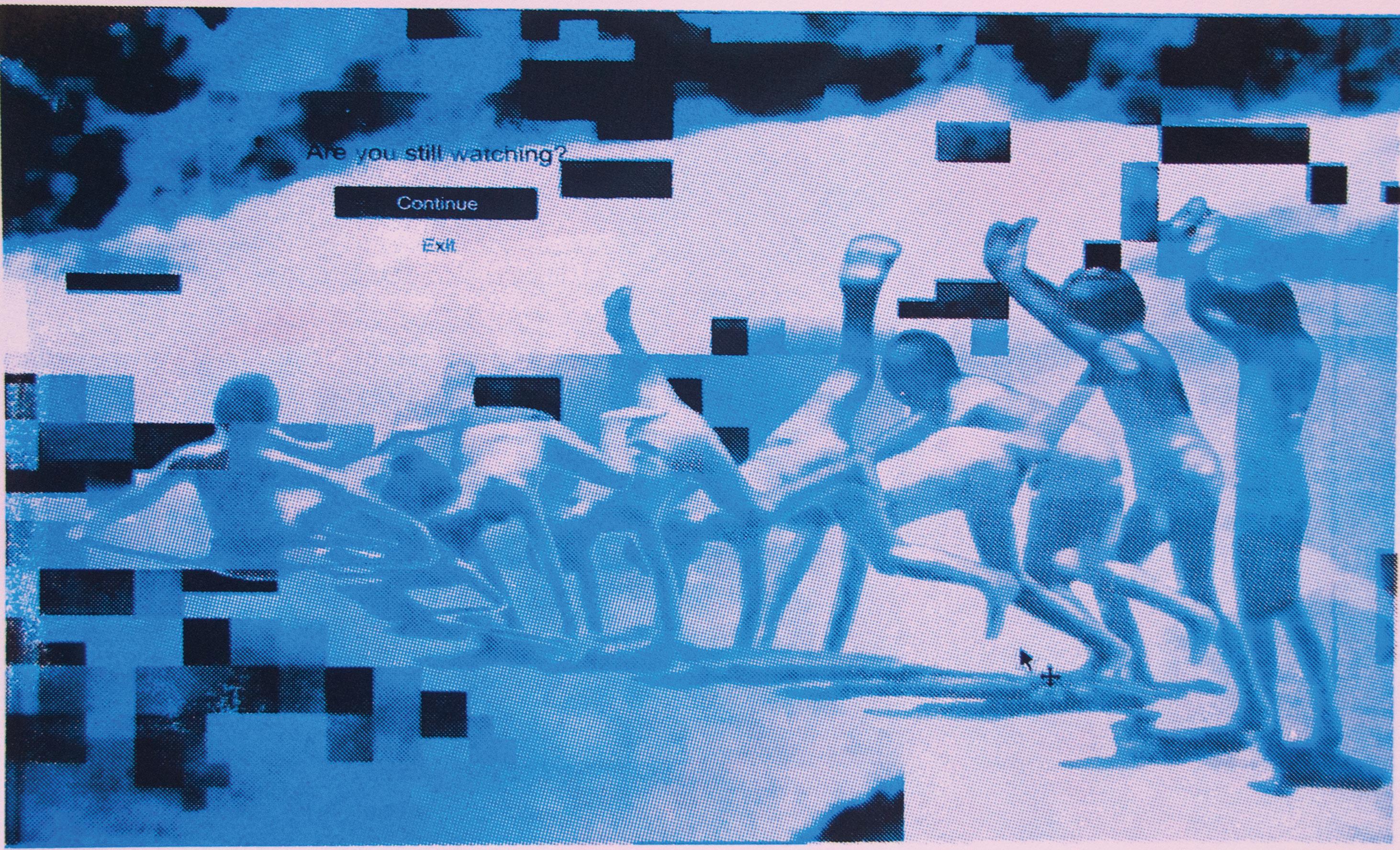
43
Please (don’t) Stop Looking, Screen print on hand-dyed paper, 15.5” x 23”, 2022
Serpiente de las Estrellas, Photopolymere gravure, Chine-collé, Screen print, and gold leaf, 30” x 22”, 2021
TALLER SANAAR
San Francisco, California
Taller Sanaar (TA - YER SAN- AR), composed of Jessica Sabogal, a Colombian-American muralistx and printmaker, and Shanna Strauss, a Tanzanian-American mixed media artist, is a queer artist duo based in California. Our collaborative practice combines photopolymer gravure, silkscreen, relief, and Chine-collé to expand the boundaries of traditional printmaking, while questioning and disrupting our current social and political conditions. Each piece we create is a celebration of our differences and a symbol of our liberation.
“Serpiente de las Estrellas” is part of an ongoing series, This Woman’s Work , which seeks to visually illustrate the labor that queer, trans, and gender nonconforming women of color undertake to maintain the well-being of their families, communities, and society at large, that too often goes unnoticed, underappreciated, or underacknowledged. For this project, each collaborator represented in the work is interviewed on how they individually identify and perform invisible labor in their own respective lives.

44
2-Step Illusion, Lithograph, 14” x 11”, 2022
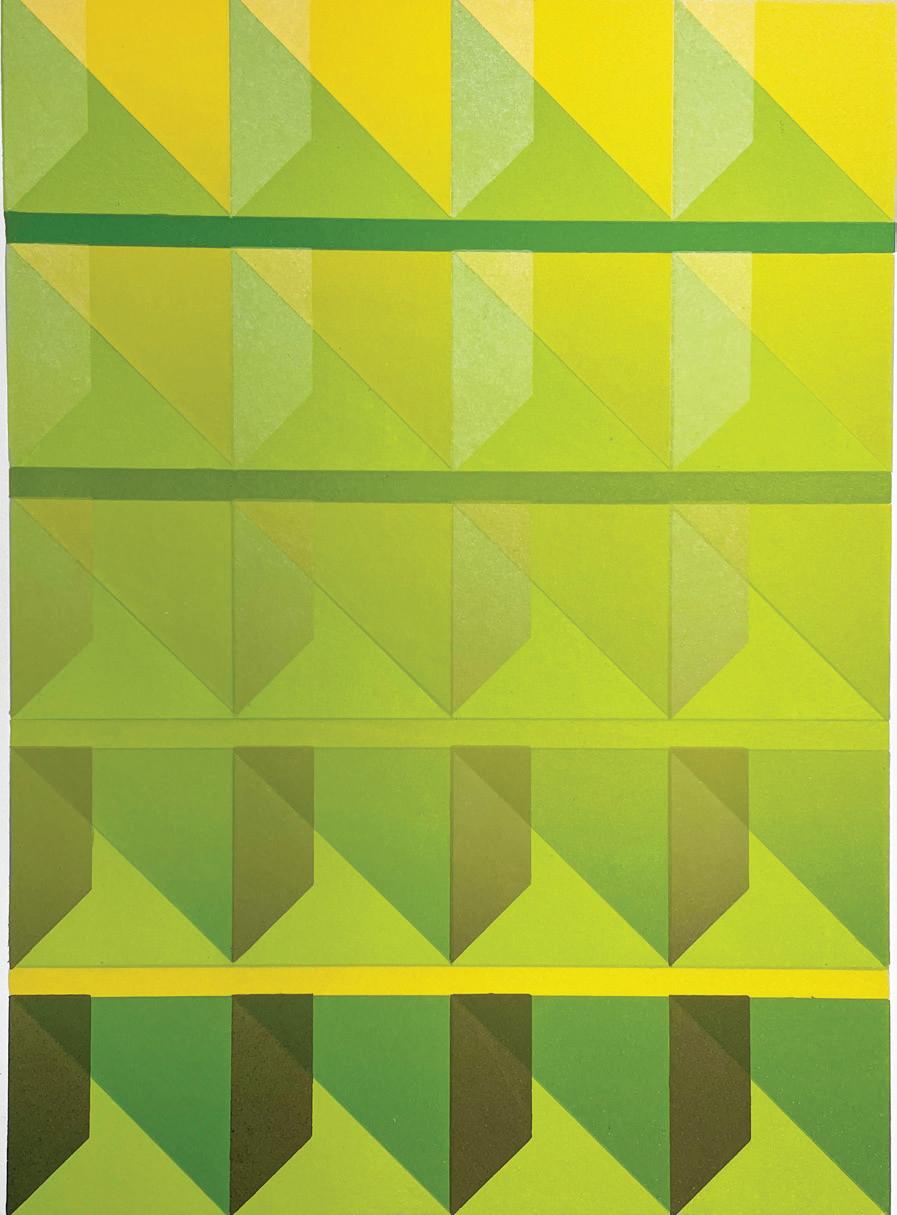
KRISTIN SARETTE
Albuquerque, New Mexico
Through print media, I examine continual growth and transformation. Foremost, I strive to keep my aesthetics and message relatable and simple. I began working in print specifically because of the access it has achieved in the dissemination of visual and written information. I have always been attracted to a message of inclusivity, and printmaking provides just that.
My work is an interpretation on the past informing the present through form, space, and a unifying color field. I find dense meaning in formal contributions, without understating conceptual motivation. Emotional psychology, and the attributes individual colors carry, are deciding factors in how I progress in a composition. The very idea in which a color is subjective, and changes according to the proximity of another color, draws amazing parallels between the life force of color and the human condition. I create space for the viewer to observe these parallels without using narrative mark-making as a guide for how to feel, or what to carry away from the work. In this way, I create a mindful practice of inquiry, or a meditation, for the viewer.
45
16”, 2022
TERRY SCHUPBACH-GORDON

Tobaccoville, North Carolina
My effort to live gracefully within a body increasingly defined by disability requires that I redefine traditional notions of beauty, strength, independence, and fragility. Disability impacts all aspects of my life. It is part of my identity and, as such, is the lens through which I see the world. I create works that are intentionally beautiful and affirmative in their meaning. Water’s buoyancy lifts and supports all bodies, which is why it is a powerful metaphor within the disability community. My work is part of an effort to reframe the language around disability and to address not the physicality that we do not have or have lost, but rather to speak about what we know and how we know it. I know and “claim” grace by redefining and renaming what it means to be “full of grace”. Printmaking is my language, and my work is cut, pieced, reassembled, and sewn together much as my own life is. It is my attempt to reimagine fragility and reembrace a kind of strength that includes that fragility.
46
Gravity Reversed #1, Intaglio woodcut collage with letterpress, 24” x
EGOR SHOKOLADOV
Port Angeles, Washington
I create graphic art by a variety of visual art processes like pencil, pen and marker drawing, oil, acrylic and watercolor painting, and a printmaking technique called etching. In fact, I often mix several of these methods and media in my artwork to better express my thoughts and impressions. Most of my images can be compared to a riddle or a mystery of some kind. One can “read” the story behind them similar to how one would read a story in a book. I work in a variety of genres and my creations often show my mood and mental state at a given moment ranging in a spectrum from ironic and humorous to serious and reflexive. Personages and situations illustrated on my paper and canvas or engraved on zinc plates are easily relatable to and bring positive vibes into the world. I pay close attention to details, attracting the viewer to explore all parts of the story behind each of my artistic pieces with me. My style has a noticeable European shade as I am a recent immigrant from Eastern Europe.
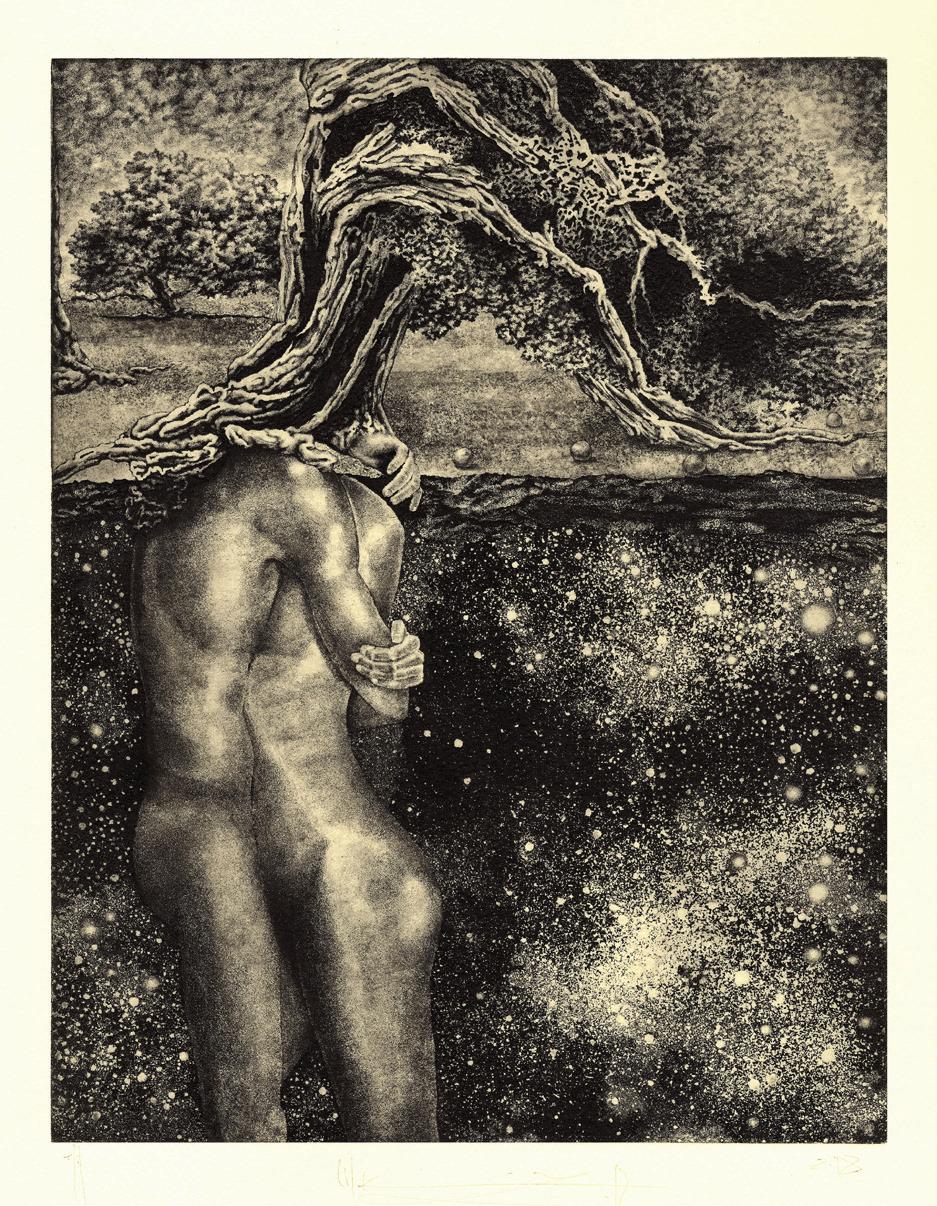
47
Apple Orchard, Etching, aquatint, soft-ground, 10.25” x 7.75”, 2018
Protest (Print) 20, Collage with lithograph, Screen print, and cut paper, 17” x 22”, 2020
SARAH SIPLING
Saint
Joseph, Missouri
My work questions political issues focusing on ideas of protest, power, and perception. I use collage methods, using many layers of different types of printmaking, from digital to silkscreen and lithography, to create physically layered prints that address the multiple ways that changes within the government impact our country as a whole and the well-being of the person as an individual. As I question the ongoing destructive political narrative, I look for the possibility of positive change.

48
Nia, Linoleum block print with Chine-collé, 30” x 22”, 2021

SHANNA STRAUSS Oakland, California
My work explores oral tradition, family legacy, ancestral memory, and spirituality in African diasporic traditions, paying homage to the women in my family and communities I am connected to. Through my work I traverse the interconnected pathways between the physical and spiritual world: past, present, and future. Fusing visual language with storytelling, I carry forth the oral teachings and ancestral wisdom gifted to me.
49
TYLER THENIKL Athens, Ohio
My work is concerned with the state of the landscape amid unprecedented environmental degradation, destruction, and human disconnection. As an artist, scholar, and environmental activist, I study sites of sublime phenomena resulting from juxtapositions of nature and industry.
Field documentation and archival research allow me to achieve an understanding of place which considers the intersections of history, ecology, and sociology. This research is the foundation of the narrative concepts represented in my artistic practice. I utilize printmaking, photography, painting, drawing, and installation to create expressive, introspective images of both mundane and extraordinary circumstances. The range of media I employ allows me to achieve a fluidity of creative expression and material collaboration as I elevate images of abandoned structures, utilitarian objects, and altered landscapes into the gallery space. This artistic practice accompanies my collaboration and volunteer work with local organizations across the Midwest and Appalachia. My goal is to work on a local level to facilitate discourse, understanding, and foster agency within the vast array of existential issues produced by late-stage capitalism.

50
Ghosts of the Gavin Plant, Stone lithography, woodcut, and watercolor, 12” x 18”, 2022
DELIA TOUCHE & MELIH MERIC
Bloomfield Hills, Michigan
Both of our works deal with erasure, culture, displacement, and diaspora while using printmaking. We started collaborating in 2021 with a project that functioned as a catalyst for a series of inquiries. As we continued working together, our works started forming a complimentary narrative. We have started to connect our experiences as minorities through the language of patterns from our respective cultures. Pattern as a form started to create further relationships between the visual elements we kept finding in each other’s works. We started to notice similarities through different forms of geometry that were present in the traditions of two very different ends of the earth. Our work aims to reflect our exchange of cultures through the perspective of two queer contemporary printmakers.
We created a visual language through acknowledging traditional imagery of Indigenous people and Islamic geometry. We combine a multitude of printmaking methods to highlight similarities that draw a parallel to our experiences in displacement and oppression. We often use blind embossment as an allegory of cultural erasure while allowing us to commit to green and nontoxic printmaking methods. In our previous collaborations we have used nontoxic ink, screen printing ink, blind embossment, and handmade paper.

51
Kestane–Primal embossed , Screenprint and blind embossment, 22” x 22”, 2022
MICHAEL WEIGMAN Columbus, Ohio
My work explores fascinations with underground subcultures from my youth, and interest in industrial era history. These two disparate sources clash, creating an abstract mythology used to illustrate my vision of contemporary issues. I employ printmaking as my primary medium due to its legacy as a mass communication device for the working class.

52
Those Who Can Are Enduring, Intaglio and serigraphy, 18”x 24”, 2022
STEPHANIE WEINER
Albuquerque,
New Mexico
My print, Women’s Emergency Brigade, 1936 is focused on the Women’s Emergency Brigade from the Flint Sit Down Strike of autoworkers in 1936–1937. Much of my printmaking has been about social justice struggles that I have participated in throughout my life. Although I was not marching in 1937, I feel a strong connection to the women in this print and their proud armband-wearing crew. My recent art seems to zero in on the swagger and unity of women that have stepped up in historic moments. While living in Chicago, I did a series of prints called More Welcome Homes about the wrongful convictions by Detective Reynaldo Guevara in Chicago and the women of Comite Exigimos Justicia that helped to free them. For the past year, living in New Mexico, my printmaking has focused on women who led the Empire Zinc Strike in 1950 in Hanover, New Mexico. Other recent prints relate to current seed bank efforts by local indigenous women. I have studied printmaking in Mexico, and the woodcut style of street art there has also influenced my work.

53
Women’s Emergency Brigade, 1936, Reduction linocut, 12” x 12”, 2022
ERIC WILSON
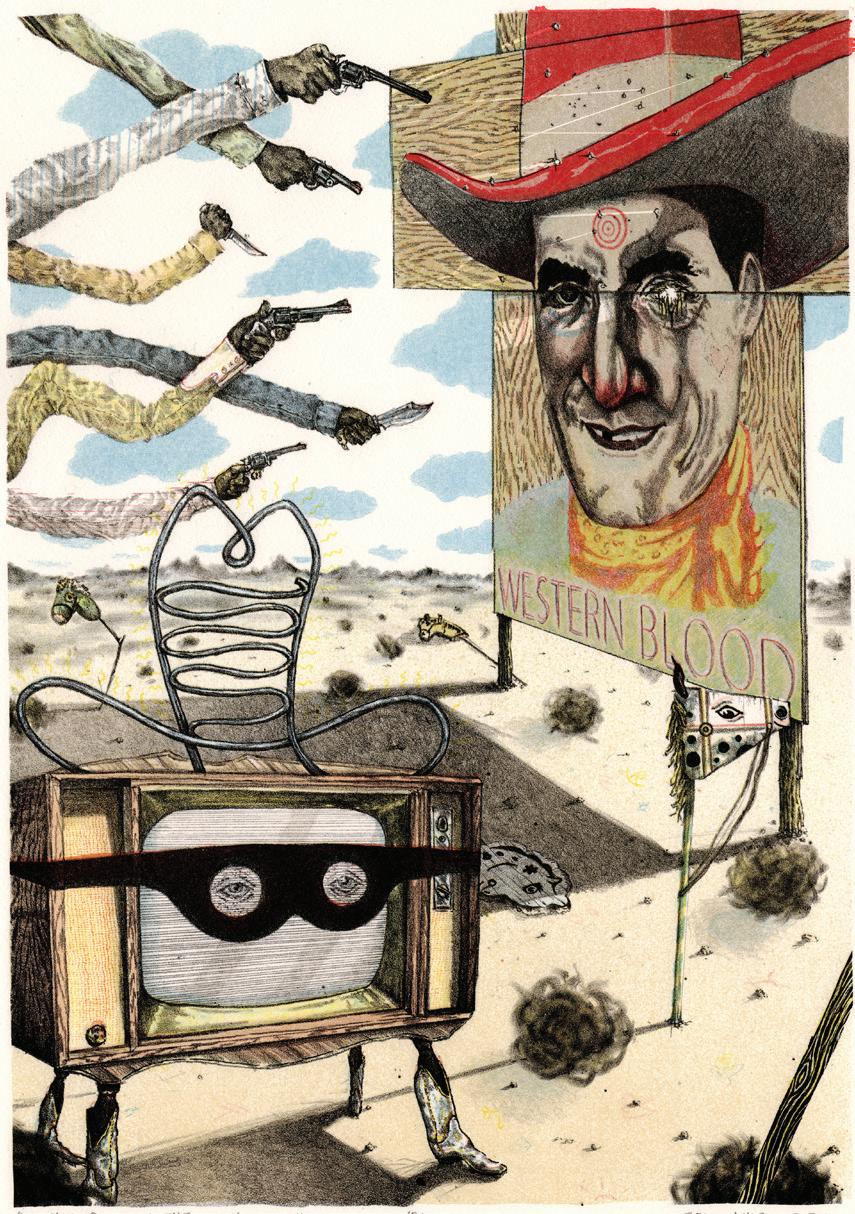
Chicago, Illinois
I was hooked on Americana, addicted to kitsch, early on. When my dad would watch westerns on TV or when my mom would bring me to antique stores, I would float away into daydreams. Overwhelmed by images and colors, I imagined the past lives I may have lived. I still am trying to understand this nostalgic reincarnation. These fantasies were condensed visions of potent Americana: the wild west, open highways, farms, fireworks, circus clowns and carnivals. To this day, I continue to see the world we live in through the candy-coated representations of our troubled past. My lithographs are a way of exorcising this alternate reality from my mind, or maybe freeing the characters who have been trapped there. It is clear to me that my early visual influences have very little to do with the realities of our history, emphasizing morality, masculinity, and indulgence instead of truth, tragedy, and exploitation. I was bound to discover that my pursuit of being a cowboy was a fool’s errand. Maybe by the end of the 20th century, the rugged hero was finally shot dead. In my recent prints, images of the West are composed of my personal experiences living in the Southwestern deserts as well as artifacts from our collective cultural memory. I hold a funhouse mirror to these Kodochromatic images of American mythology so we can see ourselves a little more clearly.
54
A Mix-Up With the Cathode Kid, Lithograph, 15” x 20”, 2020
ERIN WOHLETZ
Vermillion, South Dakota
My current body of work consists of a series of visual essays about my battle with nonbinary queerness. My self-discovery of queerness has come through a lot of internal struggle and argument. I found myself at a crossroads, an x/y axis, if you will. On the x axis I have gay/straight, on the y male/ female. As things stand, I’ve sat myself down somewhere in the middle. This is the point from which I investigate and I argue with myself. The argument? Am I, or am I not a liar? As the topic is multifaceted, it requires a multipronged approach. Each piece in this series seeks to approach this debate from a different angle in order to come to a conclusion which takes into account history, memory, risk, deception, and feeling.
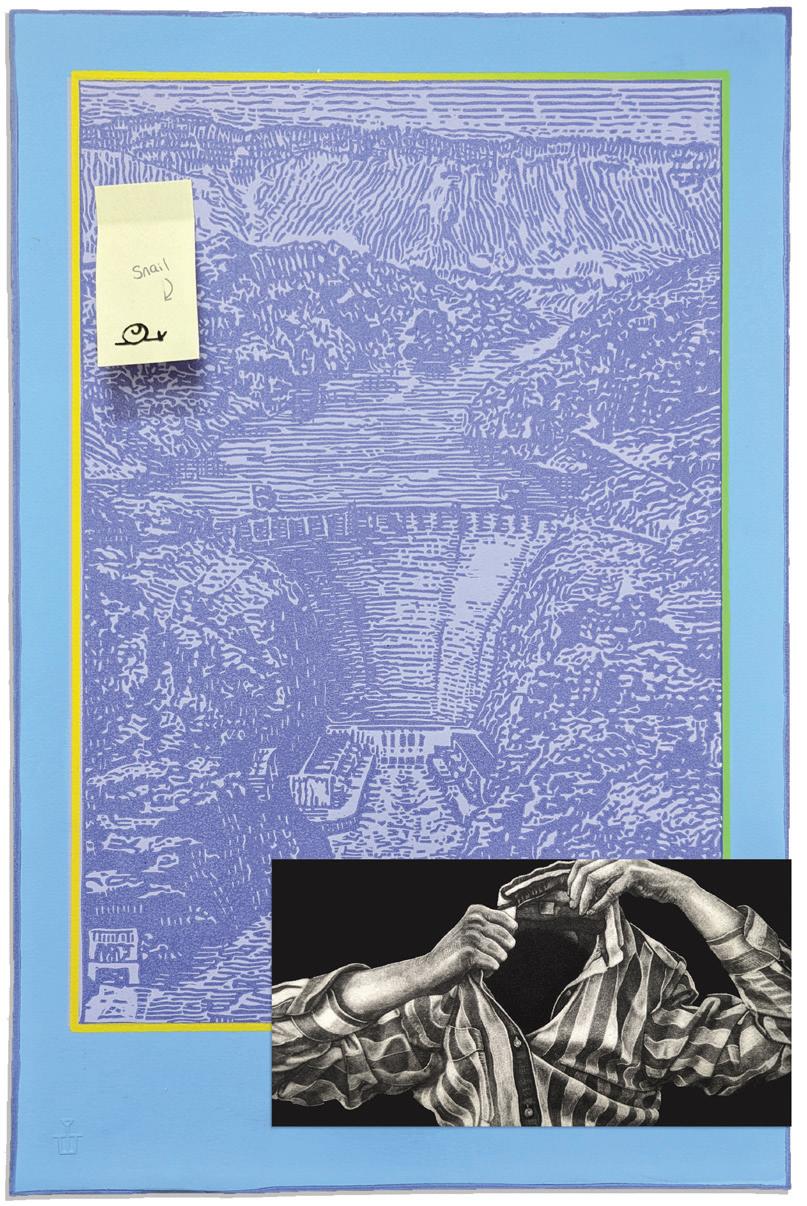
55
Don’t Touch, Under Pressure , Mezzotint, relief, and Screen print, 18” x 12”, 2022
The Golden Standard, Book arts with serigraphy and woven elements, 9.5” x 11” x 5”, 2022

SUMMER ZAH Ada, Oklahoma
My work critically analyzes the state of North American indigenous affairs by visually expressing my personal stories through printmaking and installation mediums. In accordance with my traditional upbringing, I am Jicarilla Apache and Choctaw following my mother and Navajo following my father. I carry the ancestral blood and spirituality bestowed upon me from our deities of our cultures. They are me, and I am my children. Living in a larger society outside of my community constantly challenges these teachings and, every so often, I am reminded to shed colonized ideologies and reclaim my Abaachi/Choctaw/Diné identity.
Historically, my ancestors created utilitarian objects as a means of survival; they wove rugs for clothing and baskets for storage. I use these ancient practices by printing photographs of my homelands and tribal documents onto copy paper, shred them into long thin strips, and weave these strands together into a textile. This fabric-like texture of indigenous landscapes and doctrines reclaim a present-day camping object originally meant for hobbyist transportability: a mode of nomadic living that is traditional to my people. In doing so, I subtract consumerism from familiar objects and add concept driven elements that are developed for North American indigenous viewers. If you know, you know. And if you do not, then that’s okay; there are still other perspectives at work to engage you in our conversation.
56
ALEXANDRA ZUCKERMAN
Bloomfield Hills, Michigan
My work illuminates the particularity of the mundane daily interactions between my friends and community. I create concrete residues of ephemeral experiences such as shared conversations, meals, nicknames, and routines. Internal languages reveal nuanced needs, fixations, and desires of the communities who use them. By working in the archival processes of printmaking and book arts, I complicate the ephemerality of the content, tracing and expanding the echo of memory-fragments of verbal conversations. Printed labels and names function as descriptions of the intangibilities of internally recalling the intimacy of shared mundane experiences. By hand-stamping text onto archival printmaking paper, I set forth those feelings into a lasting form, extending the “echo” of my indices of connection. I mediate access by abstracting remembered phrases from the context of full sentences or complete thoughts. I choose words ripe with particulars of cultural context to allow viewers to search for resonance within a personal dictionary of enticing, sticky, smooth, delicious words. I feel most satisfied when I am known, and I want others to both see themselves or their experiences reflected in my work while respectfully acknowledging the distance the viewer innately holds.

57
Fine Wine/Live Bait, Hardcover accordion book with hand-stamped type, 2” x 2.5”, 2022
info@printaustin.org printaustin.org

Thank you to all that supported The Contemporary Print 2023, inlcuding Debra Watkins of Link & Pin Gallery for contributing the prize. This project is supported in part by the Cultural Arts Division of the City of Austin Economic Development Department and other private donors.



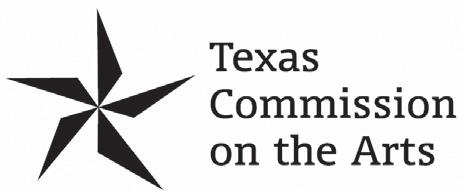
 Rashaun Rucker
Rashaun Rucker
























































